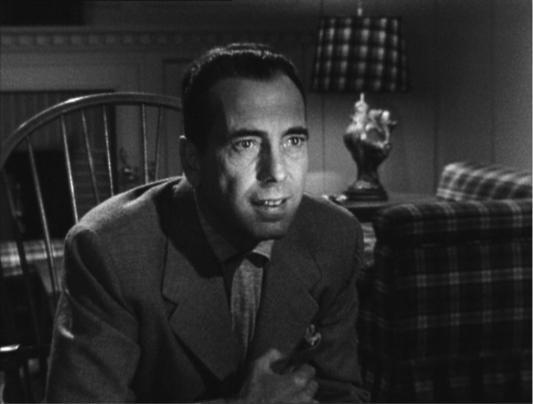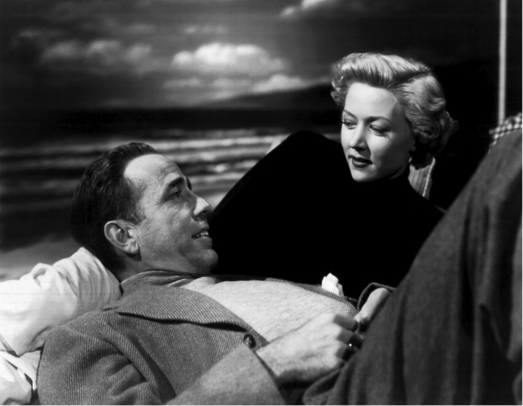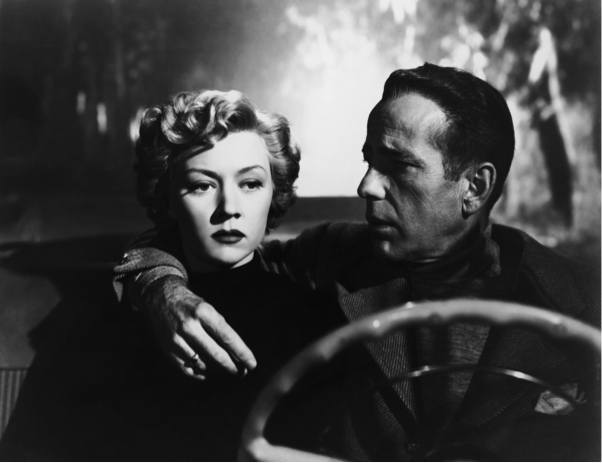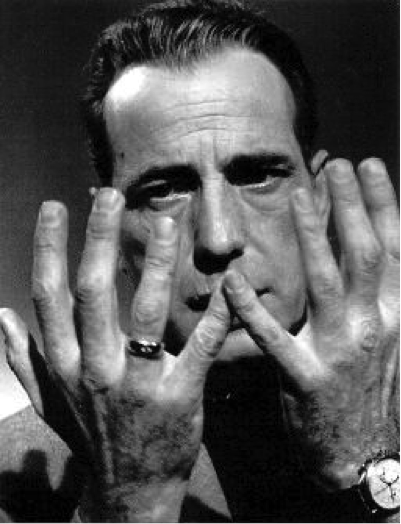Does “In a Lonely Place” adhere to or challenge traditional gender roles?
We know exactly what we’re getting when we meet Dixon Steele (Humphrey Bogart) in the noir drama In a Lonely Place (1950). His reputation precedes him: a cop turned film writer with a violent streak and a hair-trigger temper for perceived insults. From the start, we learn he has been in multiple fights and has beaten at least one girlfriend before the events of the film. His rigid masculinity is on visual display in the casting of a craggy 51 year-old Bogart, already well known to fans for his tough-guy roles, including noir shamuses Sam Spade (The Maltese Falcon, 1941) and Philip Marlowe (The Big Sleep, 1946). And unlike Spade or Marlowe, the character’s very name points to his aggression. “Dixon” means “son of Dick,” where “Dick” is short for “Richard,” a name comprised of the elements “ric” (power) and “hard” (hardy, strong). Steele, of course, speaks even more obviously of unyielding toughness.

When Dixon meets love interest Laurel Gray (Gloria Grahame), we see pointed gender contrast. Grahame is 24 years Bogart’s junior (a disparity also seen in Bogart’s films with Lauren Bacall) and styled for Hollywood glamour. However, she also has a tough edge, including qualities of self-possession and independence. And she displays an open sexuality, wearing lingerie while standing on her balcony and speaking of at least one significant past lover. But she is neither malicious nor evil, separating her from the noir femme fatale. Like Dixon, her name is also significant. The laurel is a tree with ample symbolism: to the Greeks, it indicated high status and a laurel wreath was given to athletic champions in honor of Apollo, who wears a laurel crown in classical imagery. Apollo was the god of many things, including light, truth, prophecy, healing, and poetry. The Laurel of In a Lonely Place represents many Apollonian traits, beginning with her role in truth-telling when Dixon is first accused of murdering the young woman he brought to his home to summarize the novel for his newest script assignment. Laurel saw and stated that he did not follow the ill-fated Mildred (whose name means “gentle advisor”) after she left his apartment. Soon after, Laurel brings light into Dixon’s life in the form of love and support, and acts as a muse (as well as typist) for his writing.

Because this is noir and not romance, however, all does not remain sunny long. In this context, we can consider gender and Laurel’s surname as well. “Gray” could not be clearer as an indicator of the in-between space in which Laurel comes to find herself with Dixon. She is neither passive nor innocent, but she yields her independence as she accepts and returns Dixon’s love. She exemplifies a mediation of a “black and white” worldview for both of them, where a noir man can become tender and an experienced noir woman less cautious and hard. But men do not take their wives’ names, and the gray space Laurel Gray signifies is shown to be for her alone. Dixon Steele does not bend.
Perspective is as central to noir as character types when considering gender issues. Dixon and Laurel both live in the titular “lonely place” until they find happiness together for a time. Yet our perspective shifts as tension builds, from Dixon’s to Laurel’s point of view. We follow Dixon as he stumbles through scenes of resentment (at what his chosen career requires), callousness, and violence. As he is cleared temporarily of murder charges by Laurel and woos her, Dixon’s masculine perspective dominates. We may not identify with Dixon, but we see what he sees and want the union he wants. This viewpoint shifts after the night of the dinner party, when Dixon’s anger at learning he is being talked about behind his back (about the murder) by the wife of his policeman friend (Frank Lovejoy) leads him to drive off recklessly and then beat a high-school football star almost to death. Laurel yells at him to stop from the passenger seat, and only her warning that he’ll kill the boy stops Dixon from crushing his skull with a boulder. In macabre fashion, this experience leads Dixon to the sudden discovery of the best lines he has ever written: “I was born when she kissed me. I died when she left me. I lived a few weeks while she loved me.”

The film turns on these lines and their gender implications: here, Dixon announces the film’s inescapable ending. He asks Laurel to repeat the lines, but she can recite only the first two, enacting her role as Apollonian prophet as well as culpable agent in their relationship. From Dixon’s perspective, she has brought the violent man of steel to loving life, but she will also be his death. In traditionally gendered terms, blame is placed upon her. Beauty must tame the Beast. If she fails to do so, she must accept responsibility for his violence and inevitable isolation and misery.
Dixon’s lines, however, are proved false by the film because we shift to Laurel’s perspective after this scene. Dixon’s long-suffering agent (Art Smith) directly expresses his disappointment that Laurel has become increasingly afraid of Dixon’s temper. She is now even wondering if he might actually have murdered Mildred. The agent had hoped that this Beauty might actually have tamed the Beast. However, he is also sympathetic with Laurel because he identifies with her plight. Even after Dixon hits him in the face, he forgives. But Laurel’s relationship is not a professional one in which she could keep distance when necessary. Laurel has been planning to spend the rest of her life with Dixon. And she finds she simply cannot.
When Dixon actually attempts to strangle Laurel—his sole but extreme act of violence against her—we know all is over between them. However, unlike the Beauty and the Beast tale as it is commonly told, in this noir version, Beauty rejects culpability for the Beast’s actions, regardless of what causes them. Dixon may “die”—at least where hope and love are concerned—but his violence is his fault, his responsibility. No one in the film, not even Dixon in the end, denies this.

This means the film’s conclusion offers a message about gender that perhaps only a noir could in the Hollywood of 1950. Laurel Gray is no villain. She has the cynicism and experience of a femme fatale but offers the selfless love and devotion of the noir “good woman.” She thus occupies a rare “gray” space as a female character, blamed neither for loving the hypermasculine Dixon nor for leaving him. Whether Dixon’s extreme behavior is read psychologically or sociologically, it indicates his inability to live a life beyond a gendered black-and-white.

